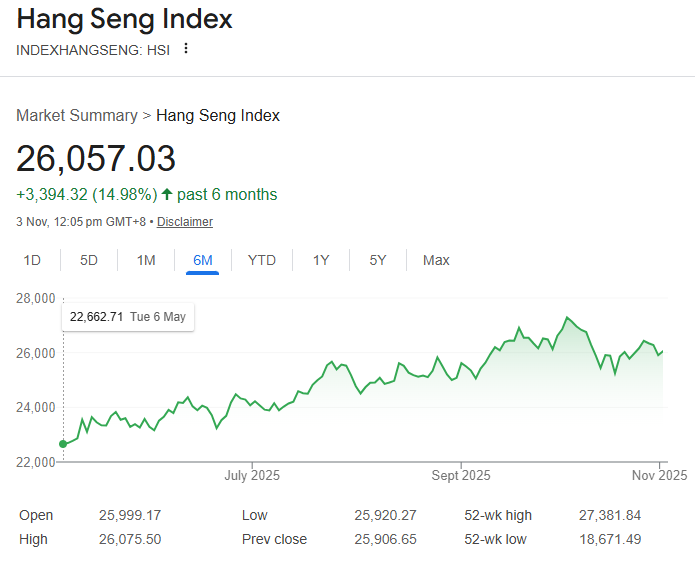市场资讯及洞察
%20(1).jpg)
震荡中的信号,港股能否迎来真正的底部?
10月,恒生指数延续回调格局,全月累计下跌948点,月初触及27,381点高位后快速回落至25,145点,跌幅达到61.8%的黄金比率水平,随后虽反弹至26,588点,但未能持续突破,显示短期受均线压制,向上动力有限。内地9月制造业PMI创半年低位且低于预期,加上全球宏观因素如美元走强、通胀压力持续,使恒指多次受挫,市场情绪谨慎。

进入11月,恒指夜期先行反弹69点,显示短期市场情绪略有回暖。此前美联储降息预期和中美贸易谈判利好消息已陆续落地,提供有限支撑,但短期缺乏新利好刺激,恒指重返高位可能性有限。若A股走势改善或科技股业绩超预期,恒指未来两个月仍有机会向今年高位27300点挑战。
本周一盘中,恒指回到26,000点附近震荡,显示市场仍在观望。技术面上,强势股指数微升,弱势股指数下降,优质板块仍具一定抗跌能力。整体来看,港股短期延续震荡整固格局,预计仍在25,300至26,300点区间震荡整理。

市场个股表现
从板块来看,科技股受业绩不及预期及全球芯片需求疲软影响出现回调;高股息蓝筹如银行、公用事业等抗跌板块成为资金避险首选;部分资源类个股受金属价格反弹支撑出现阶段性上涨;房地产板块风险仍存,部分开发商财务困境对市场情绪形成压制。总体而言,港股呈现“震荡筑底”态势,反映出市场在基本面、政策面及宏观因素间的博弈。
主要影响因素
- 美联储政策预期主导资金流向
多位美联储官员暗示降息窗口可能在明年上半年开启,短期推高风险资产包括港股和A股的资金流入。然而,美国通胀仍保持黏性,政策宽松节奏不确定,使市场短线资金频繁进出,缺乏持续上涨动力。对于港股而言,这意味着短期资金流入可能只是“阶段性反弹”,而非趋势性上涨。 - 内地经济复苏分化,港股估值修复受限
中国10月制造业PMI略低于荣枯线,显示复苏力度仍不足。尽管政策持续宽松,如专项债加速发行、房地产融资边际放松,但企业盈利恢复仍需时间。港股估值虽处历史低位,但市场仍在等待更强的基本面催化。投资者可关注政策落地力度及企业盈利改善的信号,这将决定港股后续的估值修复空间。 - 地缘局势与全球风险偏好
中东紧张局势持续,提升全球避险情绪,推动黄金、原油价格上行,部分风险资产承压。港股短期可能面临外资重新配置至美元或避险产品的压力,削弱流入力度。同时,人民币汇率波动也让南向资金趋于保守,进一步增加市场的不确定性。 - 宏观经济数据与市场情绪
美国通胀压力仍存,市场对降息预期降温,加息预期增强可能导致资金流出香港,从而对港股形成下行压力。中国经济数据虽显示复苏,但房地产市场调整拖累整体增长,使市场短期内难以形成强劲上涨动力。 - 行业特定新闻
中国科技行业监管政策仍是市场关注焦点。虽然监管有所缓和,但未来可能出台的新规仍对科技股产生压力,导致板块短期承压。投资者应关注科技股业绩发布及政策变化,以判断其中长期投资价值。 - 地缘政治因素
中美关系紧张、贸易摩擦及技术竞争仍在,对市场情绪形成影响。国际贸易环境的变化可能影响港企盈利前景,从而影响港股表现,尤其是出口导向型及高科技板块。
结构性机会与市场影响
尽管港股整体震荡,但结构性机会逐渐显现:高股息、现金流稳定的金融与公用事业板块受机构青睐;科技股短期承压,但AI、半导体及互联网龙头中长期前景仍被看好;新能源与资源板块受能源转型及金属价格上涨支撑;内地消费和旅游板块若政策落地,有望迎来补涨。
如果政策与市场流动性同步改善,恒指有望逐步筑底并展开估值修复;反之,若全球通胀回升或地缘风险加剧,市场可能继续维持震荡格局。短期来看,恒指预计将在25,300至26,300点区间震荡整固,投资者应关注内地经济数据、科技股业绩及全球宏观因素对市场的影响。
总体而言,港股正处筑底期,中长期投资价值逐步显现。投资者应保持审慎,密切关注市场动态,并结合板块机会进行合理配置,以应对潜在不确定性。
免责声明:GO Markets 分析师或外部发言人提供的信息基于其独立分析或个人经验。所表达的观点或交易风格仅代表其个人;并不代表 GO Markets 的观点或立场。
联系方式:
墨尔本 03 8658 0603
悉尼 02 9188 0418
中国地区(中文) 400 120 8537中国地区(英文) +248 4 671 903
作者:
Alena Wang | GO Markets 墨尔本中文部


USD continued the move lower sparked by a somewhat dovish Powell in Wednesdays FOMC meeting. And ahead of today’s key NFP print. DXY did hit highs after hot labour costs data, though quickly reversed to hit 3-week lows of 105.29, closing at session lows and looking to test the major support at 105.
JPY was the clear outperformer of G10 currencies, helped by a Reuters report that BoJ data suggesting that the sharp spikes in Yen strength on Monday and Wednesday this week were indeed BoJ intervention. USDJPY dropping almost 4.5% from the spike high early in Monday’s session to be hovering just above the 153 mark coming in to today’s APAC session. CHF was also an outperformer in Thursday’s session, led higher by a hot April Swiss CPI print where the headline figure of 1.4% Y/Y was well above the expected 1.1%.
USDCHF dropped to a low of 0.9094 before finding some buyers at the April support level of 0.9085, this will be a key level to watch in this pair ahead oh US NFP later today.


Mondays FX trade was relatively quiet on ahead of a some key central bank meetings today in the RBA and especially the BoJ. USD saw gains with the Dollar Index (DXY) rising from lows of 103.33 to highs of 103.65, with the index heading into APAC trade near Monday’s session high after yields were higher across the curve ahead of key risk events this week. JPY stuttered against the Dollar with USDJPY rising slightly and holding above the 149 level ahead of today’s BoJ rate decision.
The latest from Nikkei suggests the BoJ is set to end NIRP, end YCC and also end ETF purchases at today’s meeting. Markets are not fully convinced though with rates futures pricing in around a 50-50 chance of a move from the BoJ today, with April being the timeline some economist’s favour. AUDUSD was flat ultimately flat with AUDUSD rallying modestly in the APAC and UK session before paring gains in the US session ahead of today’s RBA meeting.
The Aussie central bank is widely expected to hold rates, but it will be the statement and presser to see what level of tightening bias (if any) the RBA still holds that will move the Aussie. Gold bounced back modestly, despite a mostly bid USD and higher yields, finding buyers and holding the key 2150 USD an ounce support level.


The negative dollar reaction to a modest tick-up in US jobless claims yesterday (231k versus consensus 212k) where the US Dollar Index (DXY) dropped from session highs at 105.74 to close at session lows of 105.20 seems to be telling FX traders that tells us that: a) markets are probably lacking some sense of direction in the period between payrolls and US CPI. b) the generally overbought dollar remains quite vulnerable to even slightly softer US data releases. c) markets may be buying in more convincingly on the softening US jobs market narrative. Beyond very short-term price movements, it’s looking like the key for the USD to trend materially lower remains inflation. Consensus is looking at 0.3% month-on-month core CPI print on Wednesday, which is still too high for the Fed to start cutting rates this summer.
Today’s US calendar includes only the University of Michigan surveys. Markets will be watching closely whether the medium and long-term inflation expectations have moved at all from April’s 3.0/3.2% levels. From the Fed the most interesting speaker will be Neel Kashkari, who recently argued for a higher neutral rate, which would suggest current monetary policy is not as restrictive as perceived.


USD was notably lower after what was seen as a dovish FOMC meeting on Wednesday. The Fed 2024 median dot was left unchanged with 3 cuts for 2024 still the Fed forecast but the dovish part came at the presser where Fed Chair Powell downplayed the hot January and February CPI numbers. This dovish tilt saw risk assets surge and the USD dump.
USDJPY bucked the weak Dollar trend pushing up to 152 before the result from the FOMC saw it pare some of those gains. A hawkish BoJ source reporting in Nikkei that suggested another hike could come in July or October also supporting the Yen somewhat. There is also speculation if the Yen weakness were to continue the BoJ/MoF could step in to intervene, with ING noting that local accounts felt that 155 would be red line.
Gold ripped to all time highs, with XAUUSD hitting a high of 2222 USD an ounce on the back of USD weakness and falling yields post FOMC, before falling back just above the old high at 2195 heading into the APAC session. Today ahead, more Central Bank action out of the BoE and SNB for FX traders to look forward to.


USD was slightly lower on Monday with DXY hitting a low of 104.140, holding above the 104 support level. News was light with only New Home Sales of any note, which missed modestly to the downside (662k vs the expected 675k). There was some Fed speak, the highlight being Fed hawk Bostic where he reiterated his desire of just one rate cut in 2024, this failed to make much impact on the Dollar though.
AUD and NZD saw gains to differing degrees against the USD with AUD outperforming, continuing the steep rally in AUDNZD to see the pair touching on 1.09 and firmly in overbought territory. Both AUD and NZD supported by the surprise Yuan fix by the PBoC that was much firmer than forecast. AUDUSD initially tested Friday's low at 0.6510, before the fix and improving risk sentiment saw it reverse course to hit a high of 0.6546.
USDJPY was ultimately flat in a tight ranged session. Some more jawboning from top currency diplomat Kanda saying that the BoJ has been closely watching “FX moves with a high sense of urgency and will take appropriate steps to respond” saw the talk of intervention arise with Bank of America noting that intervention is seen as a 'realistic option' to support the Yen, especially if the USDJPY cross rises to the 152-155 zone.


JPY was the currency everyone was watching coming into the pivotal BoJ meeting on Tuesday. The BoJ, as widely telegraphed, ended 17 years of negative interest rates, ETF purchases and their yield curve control policy. While a big move from the central bank there was no real surprise, with USDJPY surging to touch on 151, well into the “intervention zone” above 150.
The US Dollar Index was bid on JPY weakness, seeing DXY briefly rise above 104.00 to a peak of 104.06 in the UK session before paring some gains head of today’s closely watched FOMC meeting. AUDUSD dropped to 1 week lows after the RBA rate decision which left rates on hold as expected, but pulled back slightly on the tightening bias namely a language change from “further increase in interest rates cannot be ruled out “ to “not ruling anything in or out on interest rates”. NZD saw weakness in sympathy of the Aussie although AUDNZD saw marginal gains but failed to breach 1.08 with a high of 1.0793.

